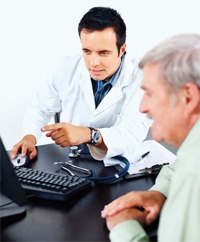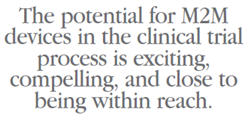Continuous Patient Monitoring In Clinical Trials: Preparing For Prime Time
By Neil de Crescenzo, senior vice president and general manager, Oracle Health Sciences Global Business Unit
 The clinical trial data capture process has made tremendous strides over the last 15 years. The age-old process of having clinical staff and investigators recording patient information from various inputs (medical instruments, laboratory reports, clinician notes, patient diaries, etc.) on paper-based case report forms, then manually entering this information into a database is fading into history. Electronic data capture (EDC) is rapidly becoming the new standard, yielding impressive productivity gains and helping to improve data accuracy.
The clinical trial data capture process has made tremendous strides over the last 15 years. The age-old process of having clinical staff and investigators recording patient information from various inputs (medical instruments, laboratory reports, clinician notes, patient diaries, etc.) on paper-based case report forms, then manually entering this information into a database is fading into history. Electronic data capture (EDC) is rapidly becoming the new standard, yielding impressive productivity gains and helping to improve data accuracy.
Now that EDC has evolved from leading edge to the norm, we are already looking ahead to the next disruptive technology. The automated solutions that have emerged in the last decades have helped us to make great strides in improving the efficiency of clinical trial data capture and management. They have not yet, however, enabled us to enter a new era of more accurate and complete data and greater insight, as well as significantly faster clinical development processes.
 Change may be coming, and quickly, with increased focus on machine-to-machine (M2M) technology that is beginning to make its mark in industries ranging from auto manufacturing to public utilities. The M2M model uses wired or wireless connectivity to exchange information and communications between Web-connected devices without human intervention. Healthcare and life sciences are very much in the mix, and we are beginning to see the emergence of wireless devices that enable continuous, remote patient monitoring. For example, in the summer of 2012, the industry was abuzz with news of FDA approval of the first ingestible event monitor (IEM) for medication adherence. The embedded monitor sends a signal through the skin, logging both the time the user took the pill and the unique identifier for that particular medication. A companion sensor worn on the skin receives and logs the signal from the IEM, as well as captures continuous readings of the patient’s heart rate, temperature, activity, and rest patterns to collect as much context data as possible. The IEM can collect more than 5,000 data points per minute, which can be uploaded to a computer or mobile device at any time. The potential for M2M devices in the clinical trial process is exciting, compelling, and close to being within reach.
Change may be coming, and quickly, with increased focus on machine-to-machine (M2M) technology that is beginning to make its mark in industries ranging from auto manufacturing to public utilities. The M2M model uses wired or wireless connectivity to exchange information and communications between Web-connected devices without human intervention. Healthcare and life sciences are very much in the mix, and we are beginning to see the emergence of wireless devices that enable continuous, remote patient monitoring. For example, in the summer of 2012, the industry was abuzz with news of FDA approval of the first ingestible event monitor (IEM) for medication adherence. The embedded monitor sends a signal through the skin, logging both the time the user took the pill and the unique identifier for that particular medication. A companion sensor worn on the skin receives and logs the signal from the IEM, as well as captures continuous readings of the patient’s heart rate, temperature, activity, and rest patterns to collect as much context data as possible. The IEM can collect more than 5,000 data points per minute, which can be uploaded to a computer or mobile device at any time. The potential for M2M devices in the clinical trial process is exciting, compelling, and close to being within reach.
Continuous Monitoring — Defining the Potential
WHO research from 2010 estimates that half of all patients fail to take medications properly. Adherence issues can have a dramatic impact on the effectiveness of any approved treatment. Protocol adherence is even more critical in a clinical trial in which a treatment’s efficacy and safety are being studied.
 It is easy, therefore, to see why the life sciences industry is interested in the potential of M2M technologies in clinical trials. Continuous monitoring can help researchers to confirm treatment adherence with certainty, which we cannot do today. As a result, study sponsors and managers can more accurately determine efficacy because non-adhering patients can be filtered out. In addition, it can help to facilitate subject recruitment and, ultimately, shorten the length of a trial. If participants are not adhering, trial managers can drop them quickly, yielding earlier insight into how many subjects will be required to complete the trial. Further, continuous monitoring can help to improve participant retention as recording critical data and adherence will be more convenient.
It is easy, therefore, to see why the life sciences industry is interested in the potential of M2M technologies in clinical trials. Continuous monitoring can help researchers to confirm treatment adherence with certainty, which we cannot do today. As a result, study sponsors and managers can more accurately determine efficacy because non-adhering patients can be filtered out. In addition, it can help to facilitate subject recruitment and, ultimately, shorten the length of a trial. If participants are not adhering, trial managers can drop them quickly, yielding earlier insight into how many subjects will be required to complete the trial. Further, continuous monitoring can help to improve participant retention as recording critical data and adherence will be more convenient.
Continuous monitoring can further bolster clinical trial efficiency. Today, a clinician writes down information after a patient visit, which is then entered on-site into an EDC system. Later, the study sponsor or CRO sends a verifier to validate the process and data, adding layers, time, and costs. Continuous monitoring could eliminate these processes by automatically uploading the data to the clinical data management system. No source data verification would be required, and trial sponsors and their development partners can benefit from continuous insight.
There is also a link between safety and continuous remote patient monitoring. The latter can enable trial sponsors to more readily and accurately identify potential events or side effects, such as changes to heart rate or rhythm, respiration, blood pressure, or sleeping patterns after taking a medication or undergoing a therapy.
Clearing the Final Hurdles
How can we expect the use of M2M technologies to evolve in the clinical space? For answers, we might look to the healthcare sector where we are seeing a growing number of pilots and small-scale initiatives, most frequently around cardiac monitoring and diabetic care. Widespread adoption, however, has yet to take off in healthcare due to some familiar barriers that also apply to the use of M2M devices in clinical trials. First, we see concerns about liability and security associated with new devices in the healthcare and life sciences sectors.
In addition, the technology supporting continuous remote patient monitoring is emerging quickly, and regulatory policies around its use are, at best, in their infancy. President Obama signed legislation in July that gave the FDA approval to continue to develop mHealth regulations while the Department of Health and Human Services continues to work on a “regulatory framework for health information technology, including mobile medical applications….” It remains unclear which applications and technologies will require FDA approval and what the approval process might entail. This uncertainty hinders adoption as well as device and software development.
The health sciences sector also continues to sort out standards that so far have not kept pace with technology evolution. While Internet protocol and telecommunications standards are widely used, they are not universal and, in some pilots, have led to issues with product development and rollout. In addition, there can be issues regarding changes in medical device transport protocols as well as device compatibility. The positive news is that standards such as those promoted by the Continua Alliance are gaining traction, as exemplified by Norway’s adoption of them, with other countries starting to follow.
Preparing to Put M2M Technology to Work
As government and industry lock down the remaining infrastructure, regulatory, and standards details, forward-looking life sciences organizations can begin to plot a foundation for adoption. The good news is that we have the core technologies — including data repositories, analytics, and the Internet — already at our disposal and can learn from other industries that are progressing rapidly through the adoption curve. The biggest challenge is likely to be the ability to deal with the exponential increase in data that M2M devices will capture and subsequently transmit to clinical development organizations.
Life sciences organizations are already facing a data deluge. C-level life sciences executives in a recent Oracle survey revealed their organizations are, on average, collecting and managing 78% more data than they did just two years ago. More important, nearly 30% of the life sciences execs gave their organization a “D” or “F” when asked about their company’s preparedness to deal with the data pouring into their organizations.
If pharmas and CROs are not prepared, this data deluge can prevent researchers and clinicians from turning M2M data, as well as other clinical data, into useful insights about a therapy and its effectiveness. As such, life sciences organizations are wise to begin to take stock of their data infrastructure and analytical capabilities now, an exercise that can yield both immediate and longerterm benefits.
It is also important for organizations to review current analytics and reporting capabilities to see if they can handle data streams from a variety of sources and generate reports and dashboards within acceptable timeframes. Then, they must determine what legacy systems can be leveraged and what might be needed to enable the organization to make the most of its big data today and into the future.
To prepare to take advantage of continuous monitoring technology as it comes of age, health sciences organizations and their CRO partners are wise to address their data management challenges in the short term with infrastructures that can process, store, and, most importantly, analyze unprecedented amounts of information more rapidly than ever before. Those that move confidently forward and build out a system to support these requirements will be well prepared to begin the next clinical data capture transformation journey.
